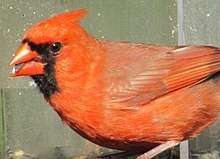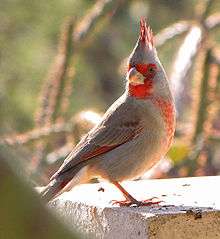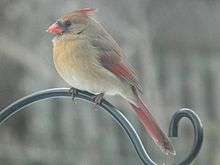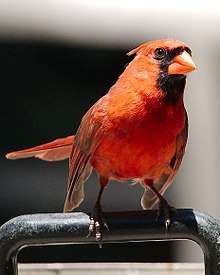Cardinal (bird)
Cardinals, in the family Cardinalidae, are passerine birds found in North and South America. They are also known as cardinal-grosbeaks and cardinal-buntings.
| Cardinals | |
|---|---|
 | |
| Male northern cardinal | |
| Scientific classification | |
| Kingdom: | Animalia |
| Phylum: | Chordata |
| Class: | Aves |
| Order: | Passeriformes |
| Superfamily: | Passeroidea |
| Family: | Cardinalidae Ridgway, 1901 |
| Genera | |
|
Periporphyrus | |

Historically, the South American cardinals in the genus Paroaria have been placed in the tanager family Thraupidae. However, DNA analysis of the genera Piranga (which includes the scarlet tanager, summer tanager, and western tanager), Chlorothraupis, and Habia showed their closer relationship to the cardinal family.[1] They have been reassigned to that family by the American Ornithological Society.[2]
Species list
(1) "Masked" clade:
- Genus Gubernatrix
- Yellow cardinal, Gubernatrix cristata
- Genus Periporphyrus
- Red-and-black grosbeak, Periporphyrus erythromelas
- Genus Caryothraustes
- Black-faced grosbeak, Caryothraustes poliogaster
- Yellow-green grosbeak, Caryothraustes canadensis
- Genus Rhodothraupis
- Crimson-collared grosbeak, Rhodothraupis celaeno
- Genus Cardinalis
- Northern cardinal, Cardinalis cardinalis
- Pyrrhuloxia, Cardinalis sinuatus
- Vermilion cardinal, Cardinalis phoeniceus
- Genus Piranga (formerly under Thraupidae)
- Rose-throated tanager, Piranga roseogularis
- Hepatic tanager, Piranga flava
- Scarlet tanager, Piranga olivacea
- Summer tanager, Piranga rubra
- Western tanager, Piranga ludoviciana
- Flame-colored tanager, Piranga bidentata
- White-winged tanager, Piranga leucoptera
- Red-headed tanager, Piranga erythrocephala
- Red-hooded tanager, Piranga rubriceps




(2) "Blue" clade:
- Genus Amaurospiza
- Blue seedeater, Amaurospiza concolor
- Carrizal seedeater, Amaurospiza carrizalensis
- Blackish-blue seedeater, Amaurospiza moesta
- Genus Cyanocompsa
- Blue bunting, Cyanocompsa parellina
- Genus Cyanoloxia
- Glaucous-blue grosbeak, Cyanoloxia glaucocaerulea
- Ultramarine grosbeak, Cyanoloxia brissonii
- Amazonian grosbeak, Cyanoloxia rothschildii
- Blue-black grosbeak, Cyanoloxia cyanoides
- Genus Passerina, North American buntings
- Blue grosbeak, Passerina caerulea – sometimes separated in Guiraca
- Lazuli bunting, Passerina amoena
- Indigo bunting, Passerina cyanea
- Varied bunting, Passerina versicolor
- Painted bunting, Passerina ciris
- Rose-bellied bunting, Passerina rositae
- Orange-breasted bunting, Passerina leclancherii
- Genus Spiza
- Dickcissel, Spiza americana
(3) Ant tanager clade:
- Genus Habia (formerly under Thraupidae)
- Red-crowned ant tanager, Habia rubica
- Red-throated ant tanager, Habia fuscicauda
- Sooty ant tanager, Habia gutturalis
- Black-cheeked ant tanager, Habia atrimaxillaris
- Crested ant tanager, Habia cristata
- Genus Chlorothraupis (formerly under Thraupidae)
- Carmiol's tanager, Chlorothraupis (c.) carmioli
- Olive tanager, Chlorothraupis (c.) frenata
- Lemon-spectacled tanager, Chlorothraupis olivacea
- Ochre-breasted tanager, Chlorothraupis stolzmanni
(4) "Chat" clade:
- Genus Granatellus (formerly under Parulidae)
- Red-breasted chat, Granatellus venustus
- Gray-throated chat, Granatellus sallaei
- Rose-breasted chat, Granatellus pelzelni
(5) "Pheucticus" clade:
- Genus Pheucticus
- Mexican yellow grosbeak, Pheucticus chrysopeplus
- Southern yellow grosbeak, Pheucticus chrysogaster
- Black-thighed grosbeak, Pheucticus tibialis
- Black-backed grosbeak, Pheucticus aureoventris
- Rose-breasted grosbeak, Pheucticus ludovicianus
- Black-headed grosbeak, Pheucticus melanocephalus
Biology
They are robust, seed-eating birds with strong bills. The family's smallest member is the 12-cm (4.7-in), 11.5-g (0.40-oz) orange-breasted bunting. They are typically associated with open woodland. The sexes usually have distinctive appearances. The northern cardinal type species was named by colonists for the male's red crest, reminiscent of a Catholic cardinal's biretta.[3]
The "North American buntings" are known as such to distinguish them from buntings of the Old World family Emberizidae. The name "cardinal-grosbeak" can also apply to the cardinalid family as a whole.
Most species are rated by the IUCN as being of least concern, though some are near threatened.[4]
References
- Yuri, T.; Mindell, D. P. (May 2002). "Molecular phylogenetic analysis of Fringillidae, "New World nine-primaried oscines" (Aves: Passeriformes)". Molecular Phylogenetics and Evolution. 23 (2): 229–243. doi:10.1016/S1055-7903(02)00012-X. PMID 12069553.
- "Family: Cardinalidae". American Ornithological Society. Retrieved Feb 1, 2019.
- Duchesne, Bob (September 21, 2012). "Proliferation of cardinals a fairly recent event". Bangor Daily News. Archived from the original on October 6, 2014.
- Search "cardinalidae" at IUCN Red List Archived June 27, 2014, at the Wayback Machine for more info.
- Stiles and Skutch, A guide to the birds of Costa Rica ISBN 0-8014-9600-4
- Hilty, Steven L (2003) Birds of Venezuela London: Christopher Helm, ISBN 0-7136-6418-5
- ffrench, Birds of Trinidad and Tobago ISBN 0-7136-6759-1
- "National Geographic" Field Guide to the Birds of North America ISBN 0-7922-6877-6
- Klicka, John; Burns, Kevin; Spellman, Garth M. (December 2007). "Defining a monophyletic Cardinalini: A molecular perspective". Molecular Phylogenetics and Evolution. 45 (3): 1014–1032. CiteSeerX 10.1.1.550.1550. doi:10.1016/j.ympev.2007.07.006. PMID 17920298.
External links
| Wikimedia Commons has media related to the cardinal family. |
| Wikispecies has information related to Cardinalidae |
- Cardinalidae videos, photos and sounds on the Internet Bird Collection
- Cardinalidae sounds on xeno-canto.org
- Northern cardinal (bird information) on petinfospot.com
- Northern cardinal, including sound and video clips, on Cornell Lab of Ornithology